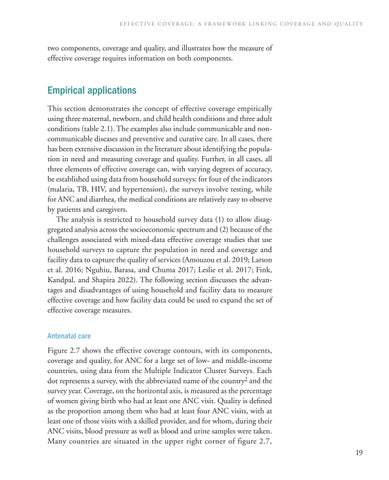EFFECTIVE COVERAGE: A FRAMEWORK LINKING COVERAGE AND QUALITY
two components, coverage and quality, and illustrates how the measure of effective coverage requires information on both components.
Empirical applications This section demonstrates the concept of effective coverage empirically using three maternal, newborn, and child health conditions and three adult conditions (table 2.1). The examples also include communicable and noncommunicable diseases and preventive and curative care. In all cases, there has been extensive discussion in the literature about identifying the population in need and measuring coverage and quality. Further, in all cases, all three elements of effective coverage can, with varying degrees of accuracy, be established using data from household surveys: for four of the indicators (malaria, TB, HIV, and hypertension), the surveys involve testing, while for ANC and diarrhea, the medical conditions are relatively easy to observe by patients and caregivers. The analysis is restricted to household survey data (1) to allow disaggregated analysis across the socioeconomic spectrum and (2) because of the challenges associated with mixed-data effective coverage studies that use household surveys to capture the population in need and coverage and facility data to capture the quality of services (Amouzou et al. 2019; Larson et al. 2016; Nguhiu, Barasa, and Chuma 2017; Leslie et al. 2017; Fink, Kandpal, and Shapira 2022). The following section discusses the advantages and disadvantages of using household and facility data to measure effective coverage and how facility data could be used to expand the set of effective coverage measures. Antenatal care Figure 2.7 shows the effective coverage contours, with its components, coverage and quality, for ANC for a large set of low- and middle-income countries, using data from the Multiple Indicator Cluster Surveys. Each dot represents a survey, with the abbreviated name of the country2 and the survey year. Coverage, on the horizontal axis, is measured as the percentage of women giving birth who had at least one ANC visit. Quality is defined as the proportion among them who had at least four ANC visits, with at least one of those visits with a skilled provider, and for whom, during their ANC visits, blood pressure as well as blood and urine samples were taken. Many countries are situated in the upper right corner of figure 2.7, 19

